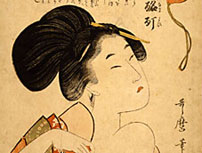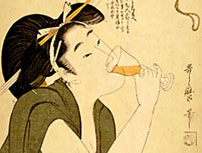Introduction
Analyzing Evidence presents case studies that demonstrate how scholars interpret different kinds of historical evidence in world history. On this screen, you see two ukiyo-e woodblock prints from the Tokugawa or Edo period in Japan (1600 to 1867) created by the artist Utamaro in 1802. These prints, titled, The Drunkard and Vulgarly called the Wanton portray women engaged in frivolous or indulgent behavior. On each print we see a pair of spectacles (watching over the young women) and messages that criticize their behavior while the images themselves are vibrant and perhaps celebratory. Analyzing these rich images offers an important window into an increasingly complex urban world.
Examine these images carefully. What do you first notice about each? What colors or features attract your attention? Who might have been the audience for these images? How can we use these prints to understand urban Japan during the Tokugawa period?
Now listen to Professor Brian Platt analyze these Japanese woodblock prints.
Note: This site uses Flash. For slower connections, visit the non-flash version.




